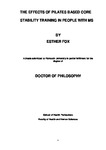THE EFFECTS OF PILATES BASED CORE STABILITY TRAINING IN PEOPLE WITH MS
| dc.contributor.supervisor | Freeman, Jennifer | |
| dc.contributor.author | Fox, Esther Elizabeth | |
| dc.contributor.other | School of Health Professions | en_US |
| dc.date.accessioned | 2015-07-28T14:29:53Z | |
| dc.date.available | 2015-07-28T14:29:53Z | |
| dc.date.issued | 2015 | |
| dc.identifier | 30008 | en_US |
| dc.identifier.uri | http://hdl.handle.net/10026.1/3477 | |
| dc.description.abstract |
Background: People with Multiple Sclerosis experience difficulties with balance and mobility. Pilates exercises are often used to address these difficulties. Design: This was a multi-centre, double blind, block randomised, controlled trial. Eligible participants were recruited from seven UK centres. Participants were randomly allocated to either: Pilates based core stability training (Pilates), Standardised Exercise (SE) or Relaxation (placebo). All received face-to-face training sessions over a 12 week period; together with a home exercise programme. Blinded assessments were taken before training, at the end of the 12 week programme and at 16 weeks (follow-up). The primary outcome measure was the 10metre timed walk (10mtw). Secondary outcome measures were the MS walking Scale (MSWS-12), Functional Reach Test (FRT ) (forwards and lateral), a 10 point Visual Analogue Scale (VAS) to determine “Difficulty in carrying a drink when walking”, and the Activities-specific Balance Confidence (ABC) Scale. Effects on deep abdominal muscles were measured with ultrasound imaging (USI) in a subgroup of patients. Independent t-tests were performed to compare groups. Sensitivity analyses were undertaken to confirm the results. A mixed factorial ANOVA analysed the effect of intervention over time upon TrAb and IO upon USI. Results: Of the 100 participants recruited, 13 relapsed leaving 94 for intention to treat analysis. At 12 weeks there were significant differences between: (1) Pilates and Relaxation for walking velocity (p=0.04), forward (p=0.04) and lateral (p=0.04) FRT. (2) SE and Relaxation for all measures (p<0.05) apart from the VAS. These remained at 16 weeks for 10mtw (p=0.04), LFR (p<0.01) MSWS-12 (p=0.03) and ABC (p= 0.03). There were no significant interactions (p>0.05) between groups or over time for TrAb and IO. Conclusions: Participants improved with both Pilates and SE in the short term; with broader and longer-lasting effects in the SE group. USI did not detect any effect of group over time. | en_US |
| dc.description.sponsorship | MS Trust, Plymouth University | en_US |
| dc.language.iso | en | en_US |
| dc.publisher | Plymouth University | en_US |
| dc.subject | Multiple Sclerosis | |
| dc.subject | Clinical Trial | |
| dc.subject | Pilates | en_US |
| dc.title | THE EFFECTS OF PILATES BASED CORE STABILITY TRAINING IN PEOPLE WITH MS | en_US |
| dc.type | Thesis | |
| plymouth.version | Full version | en_US |
| dc.identifier.doi | http://dx.doi.org/10.24382/3334 | |
| dc.identifier.doi | http://dx.doi.org/10.24382/3334 |
Files in this item
This item appears in the following Collection(s)
-
01 Research Theses Main Collection
Research Theses Main


